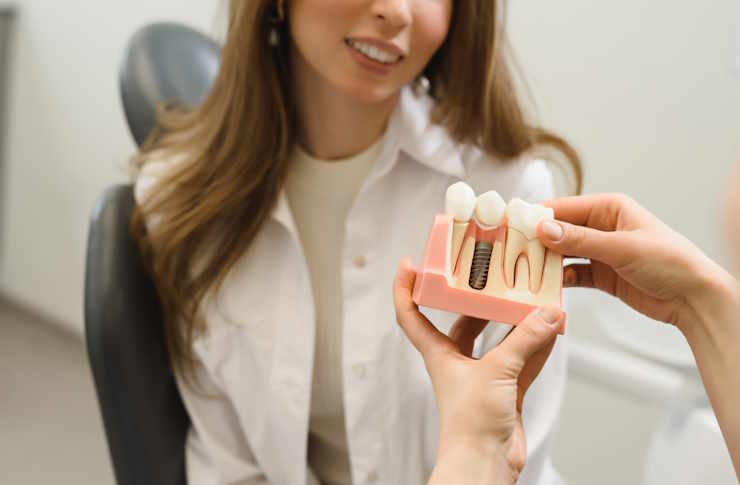How Dental Implants Can Improve Comfort and Confidence for Seniors
Missing teeth can affect more than just appearance—they can impact chewing, speech, and overall oral health. Dental implants offer a long-term solution that looks and feels natural, helping seniors regain confidence and functionality. But are they the right choice for you? This guide explores how dental implants work, their benefits, and key factors to consider before making a decision. Whether you’re looking to replace a single tooth or multiple teeth, understanding your options can help you take the next step toward a healthier, more comfortable smile

Revolutionizing Smiles: The Dental Implant Journey Explained
Dental implants have transformed the landscape of restorative dentistry, offering a permanent solution for missing teeth. This innovative procedure has become increasingly popular due to its ability to restore both function and aesthetics to a patient’s smile. As we delve into the world of dental implants, we’ll explore how they work and why they’ve become a go-to option for those seeking to regain their confident smiles.
Understanding the Basics of Dental Implants
Dental implants are artificial tooth roots that provide a strong foundation for fixed or removable replacement teeth. Made from biocompatible materials, typically titanium, these implants are surgically placed into the jawbone. Over time, they fuse with the bone in a process called osseointegration, creating a sturdy base for artificial teeth. This integration is what sets dental implants apart from other tooth replacement options, offering unparalleled stability and longevity.
The Initial Consultation: Planning Your Smile
The journey begins with a comprehensive dental examination. Your dentist will assess your oral health, take X-rays, and possibly create 3D images of your jaw. This thorough evaluation helps determine if you’re a suitable candidate for dental implants. Factors such as bone density, gum health, and overall medical history are carefully considered. During this phase, your dentist will also discuss your goals and expectations, ensuring that dental implants align with your needs.
Preparing the Groundwork: Bone Grafting
In some cases, patients may not have sufficient bone density to support an implant. This is where bone grafting comes into play. This procedure involves adding bone or bone-like materials to your jaw, creating a stronger foundation for the implant. While it may extend the overall treatment timeline, bone grafting significantly improves the success rate of dental implants for those with inadequate bone structure.
The Implant Placement Procedure
Once your jaw is ready, the implant placement surgery begins. Under local anesthesia, your oral surgeon makes a small incision in the gum to expose the bone. A specialized drill is then used to create a space for the implant, which is carefully inserted into the jawbone. The gum is then sutured closed over the implant, allowing it to heal and integrate with the bone. This healing process, known as osseointegration, typically takes several months.
The Healing Phase: Patience Pays Off
During the healing phase, it’s crucial to maintain excellent oral hygiene and follow your dentist’s instructions carefully. You may be advised to eat soft foods and avoid putting pressure on the implant site. Regular check-ups will be scheduled to monitor your progress. This waiting period, while sometimes challenging, is essential for ensuring the implant’s long-term success.
Completing Your New Smile: Abutment and Crown Placement
Once osseointegration is complete, the final steps of the dental implant process begin. Your dentist will place an abutment on top of the implant, which serves as a connector between the implant and the new tooth. After your gums heal around the abutment, impressions of your mouth are taken to create a custom-made crown. This crown is designed to match your natural teeth in color, shape, and size, ensuring a seamless blend with your existing smile.
Dental implants offer numerous benefits beyond their natural appearance. They improve speech, enhance comfort, and make eating easier compared to removable dentures. Unlike traditional bridges, implants don’t require altering adjacent teeth, preserving more of your natural tooth structure. With proper care, dental implants can last a lifetime, making them a cost-effective long-term solution for tooth replacement.
The Future of Dental Implants: Advancements on the Horizon
As technology continues to advance, so does the field of dental implantology. Researchers are exploring new materials and techniques to improve the implant process further. From 3D-printed implants to stem cell therapies that could regenerate natural teeth, the future of dental implants looks promising. These innovations aim to make the procedure even more accessible, efficient, and successful for a wider range of patients.
Dental implants have revolutionized the way we approach tooth replacement, offering a solution that closely mimics natural teeth in both form and function. By understanding the step-by-step process and the benefits they provide, patients can make informed decisions about their oral health. As with any medical procedure, it’s essential to consult with a qualified dental professional to determine if dental implants are the right choice for your specific needs and circumstances.
Disclaimer: This article is for informational purposes only and should not be considered medical advice. Please consult a qualified healthcare professional for personalized guidance and treatment.
The shared information of this article is up-to-date as of the publishing date. For more up-to-date information, please conduct own research.




